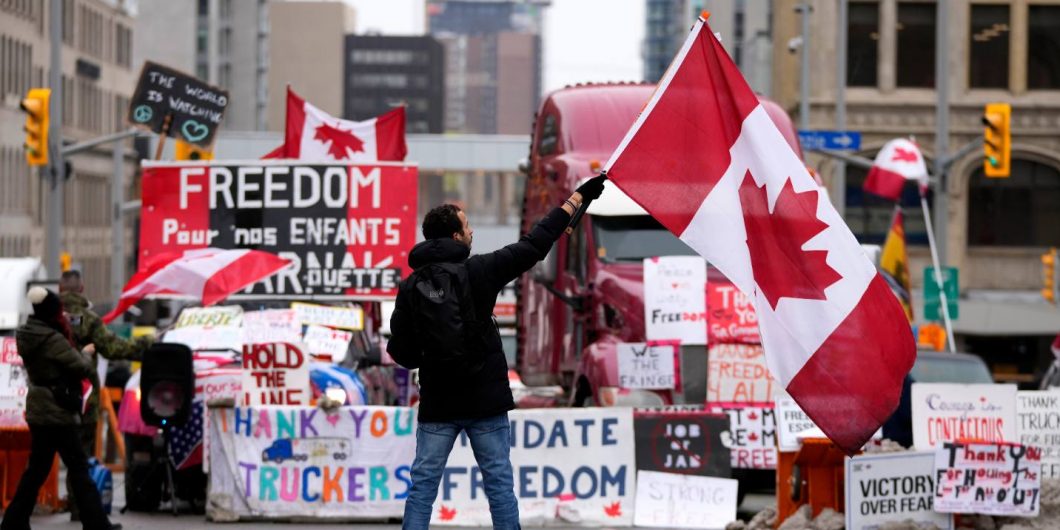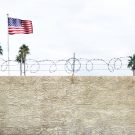Having a human rights commissioner who is conversant in the debates about human rights and Islam can only benefit Alberta Muslims.
The Aftermath of Canada's Freedom Convoy
The Canadian National Archives is located among hulking concrete bureaucratic buildings at the fringe of downtown Ottawa. It’s a severe-looking building in Ottawa’s already severe November ambience. However, the Archives is where for six weeks a showdown took place between lawyers, police, previously faceless senior government officials, and Cabinet Ministers all the way up to the Prime Minister of Canada himself. The Archives was the venue of the Public Order Emergency Commission, the public inquiry looking into the Trudeau government’s decision to declare a national emergency in response to the 2022 Freedom Convoy.
Bleakness aside, the setting is apropos. The Archives is the bookend of Wellington Street, it is mere steps away from the Supreme Court, and it is the very same location that found itself gridlocked by the Freedom Convoy’s big rigs and tractor-trailers in January 2022
On the last week of hearings, Commissioner Paul Rouleau—ordinarily a sitting judge on Ontario’s powerful Court of Appeal—was questioning the federal Attorney General and Minister of Justice David Lametti. Lametti, a former law professor, had balked at answering questions about the basis for the legality of invoking the federal Emergencies Act, claiming this information infringed upon solicitor-client privilege.
Lametti’s refusal to answer questions related to the legal opinion from the Department of Justice puts the Commission in a bind. This opinion was relied upon by key decision makers and cited by key witnesses testifying at the inquiry, including the Prime Minister’s national security advisor, the head of Canada’s spy agency, and the Minister of Finance. Their testimony suggested that this opinion laid out a novel interpretation of the threshold to invoke the Emergencies Act, and one that runs counter to the principles of statutory interpretation.
The question of what this threshold is and what is required to meet it is the core task of the Commission. It is the question everyone who spent those bleak weeks in Ottawa was there to answer: Was the federal government legally justified in invoking the Act? Shielding the Department of Justice’s legal theory upon which key decision makers relied could make the job of the Commission more challenging, if not impossible.
Commissioner Rouleau asked Attorney General Lametti directly: “I’m having a little trouble… how we assess reasonableness when we don’t know what [cabinet decision-makers] were acting on? Do we just presume good faith?”
Lametti nodded and answered predictably: “Yes, in an unprecedented circumstance, we made a reasonable series of decisions.” He was essentially repeating the evergreen salve, first observed by Cicero, of strong-armed executives the world over: salus populus es lex—that which is necessary for the public interest is lawful.
Governments at Cross-Purposes
Throughout the Commission’s firehose of disclosure—tens of thousands of documents were disclosed through an online portal, often with document dumps at 3:00 am on the day they were to be brought up in examinations—a distinct Janus-faced posture on the part of the federal government was apparent.
Out of one mouth, the feds encouraged proxies in the form of the police forces, Ottawa city brass, and provincial leadership to do the dirty work of negotiating with protestors. From the other mouth, they held daily press conferences denouncing the convoy members as racist, homophobic tin hats.
This dynamic was illustrated by the city of Ottawa mayor’s chief of staff, Serge Arpin on February 11th. Arpin was texting with Mike Jones, federal cabinet minister Marco Mendicino’s chief of staff, about police reinforcements (which were promised and sent to the Prime Minister’s cottage at Harrington Lake instead of downtown Ottawa, where local police was floundering). Arpin bucked against the ongoing federal insistence that he continue back-channel negotiations with representatives of the convoy leadership, conveying in a text “when your level of government trots out a number of ministers to denigrate the demonstrators and let them know that dialogue is impossible with the Government of Canada but somehow we should divine that we should be meeting with them to make them feel heard. That’s nauseating to say the least.”
The federal government also leaned uncomfortably on the provinces, prompting swift resistance. At one point, Ontario’s solicitor general, Sylvia Jones, snapped in response to the federal Minister of Public Safety, when he pressed her for a plan, that “I don’t take edicts from you, you’re not my fucking boss.”
Ontario’s Conservative Premier Doug Ford and Jones presumably possessed relevant information about the use of provincial laws to address the entrenched Freedom Convoy protests and what other interactions they had with the Trudeau government over events largely occurring in their jurisdiction. However, these provincial politicians opportunistically ducked out of participating in the Commission completely. Although Jones and Ford were served with summons, they asserted parliamentary privilege from being compelled to testify. The Emergencies Act is an act of last resort, so the gap in evidence on why existing provincial laws were not used will be an issue Rouleau will have to contend with.
A readout of a call between Ford and Trudeau suggested Ford was more seized with clearing the blockades at Windsor’s Ambassador Bridge, under significant pressure from the private sector as well as American counterparts (the bridge sees some $400m CAD—$300m USD—in cross-border trade daily). “I’ll be up their ass with a wire brush,” the Premier said on February 9, expressing a promise to follow up with the Ontario Provincial Police on its plan to clear the blockade. The wire brush worked— the blockade was cleared peacefully in one day prior to the Emergencies Act being invoked.
It’s also now clear that, gentle prodding of backchannel negotiations aside, the feds had been eyeing the Emergencies Act from the very beginning of the crisis. Text transcripts revealed that David Lametti, the Minister of Justice, asked his chief of staff on January 30th, the first weekend of protests, whether there was “contingency for these trucks to be removed tomorrow or Tuesday? (If they were Black or Indigenous…)” and asked “What normative authority do we have or is some order needed? EA [Emergencies Act]?”
By February 2nd, Lametti had escalated to calling on the military. “You need to get the police to move,” Lametti texted Marco Mendicino, Minister of Public Safety. “And the CAF [Canadian military] if necessary.”
“How many tanks are you asking for?” Mendicino replied.
“I reckon one will do!!” Lametti responded. On cross-examination, Lametti described the call for tanks as a joke. Gallows humour aside, the rank contempt of Canada’s ruling class for the convoy was on full display.
If the government’s sleight of hand is accepted, it will be the biggest scandal touching the rule of law in a Western democracy in recent history.
A Novel Legal Theory
The highly anticipated finale of the Commission was the appearance of Prime Minister Justin Trudeau for a full day of evidence. Trudeau is not a politician known for his gravitas— this is a man known internationally for his colourful socks, and who somebody filmed belting out “Bohemian Rhapsody” at the hotel piano bar whilst in London for Queen Elizabeth’s funeral. So the most notable thing about his appearance at the Commission was how knowledgeable he appeared about fine points of the Act. In demeanour, self-possession, and acuity, this was a Trudeau henceforth unseen.
Trudeau was well prepared, and was eager to show it off. He was especially well-briefed on the aforementioned novel legal theory the government presented about the standard of the Emergencies Act. The theory suggests that the phrase “threat to the security of Canada” in the Emergencies Act does not mean the same thing as “threats to the security of Canada” in the Canadian Security Intelligence Services (CSIS) Act, despite the Emergencies Act itself stating that the meanings in the two are the same.
“It’s right in the beginning of the section,” Trudeau said confidently in direct examination. “When the Governor in Council believes, on reasonable grounds, that a public order emergency exists and necessitates the taking of special temporary measures for dealing with the emergency, the Governor in Council may so declare.”
Trudeau went on to explain that, in his view as Governor in Council the requisite threshold of “threats to the security of Canada” was met— despite the text specifying that the meaning was “the same” as that contained in the CSIS Act, and the CSIS director confirming that such a threat never existed (although the CSIS director recommended that cabinet declare an emergency, on the basis of this novel theory of interpretation). In his view, Trudeau explained, the meaning was the same, but the “inputs” or wider spectrum of evidence the executive might consider for the purposes of invoking the Act was different.
Which is odd, because common sense would dictate that police and intelligence agencies on the ground would be the most accurate and relevant “inputs” in determining whether an emergency existed. In addition to CSIS’s conclusion, every level of police involved in the crisis— the federal Royal Canadian Mounted Police, the Ontario Provincial Police, and the Ottawa Police Service— agreed that the Emergencies Act was unnecessary and that a threat to security had not been identified.
In other words, Trudeau and his team took the deliberately stringent application prescribed by the Emergencies Act and flattened it into a reasonableness standard, claiming the Commissioner grant them deference where the exigencies of “public safety”—in an environment where a single physical threat remained unidentified— justified the creation of new criminal laws, freezing of bank accounts without a warrant and expanded financial surveillance powers.
The legislative history of the Act makes it unambiguous that this was exactly the sort of conduct it sought to prevent. The Act was introduced to replace the War Measures Act, which was widely seen as permitting overreach and civil rights abuses in response to the Front de Libération de Quebec crisis in 1970, and was meant to constrain executive action.
The Act’s drafter, Conservative senator Perrin Beatty, spoke to this point in Parliament in 1988: “a step of such far-reaching implications as the declaration of a national emergency should be required to be based upon a more objective foundation than the opinion of the Governor in Council.”
We are left, then, to believe that the proposed legal theory—Trudeau and his cabinet were entitled to determine the threshold for invoking the Act on a wholly different set of evidentiary inputs than that of law enforcement and security intelligence—won the day amongst Trudeau’s inner circles in February 2022, in the days leading up to the declaration of emergency, before being disclosed publicly for the first time in November 2022 at the Commission.
Perhaps. But the more parsimonious explanation is that after observing the fallout from the first weeks of hearings, the revelations under oath that all law enforcement, and the intelligence director himself, had concluded a threat did not exist, the Department of Justice got to work on furnishing a privileged legal opinion which conveniently shifted the goalposts for justifying the Act.
If the government’s sleight of hand is accepted, it will be the biggest scandal touching the rule of law in a Western democracy in recent history, not least because many statutes in Canada, as in the US, rely on definitions contained in different statutes and rely on a core of stable meanings.
Rouleau’s report is due to be tabled in Parliament by February 20, and will be released to the public two weeks later. Meanwhile, a majority of Canadians, even of those following the hearings, continue to support the government’s decision to invoke the Act. What happens to a country when both legal and political solutions prove impotent to keep power in check? We’ll see.


